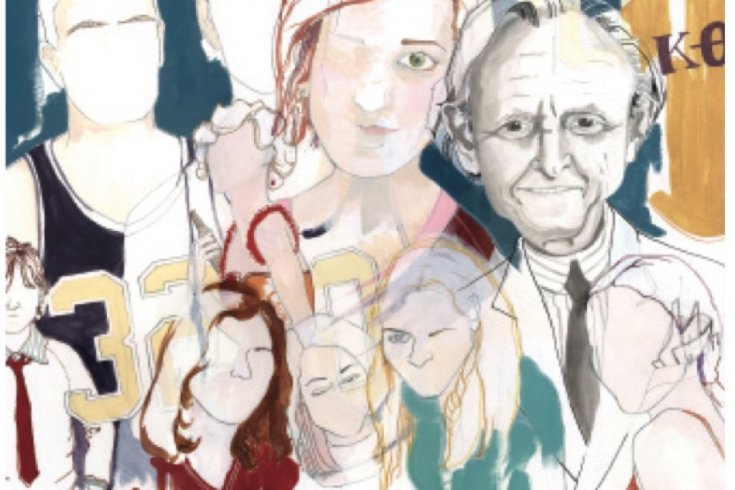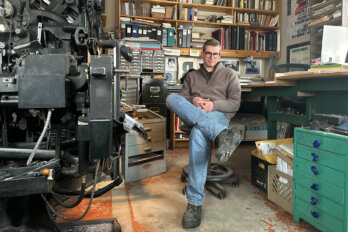
books by tom wolfe discussed
in this essay:
I Am Charlotte Simmons
HarperCollins (2004)
676 pp., $37.95
Hooking Up
Farrar, Straus & Giroux (2000)
293 pp., $35
A Man in Full
Bantam Books (1998)
704 pp., $23 (paperback)
The Bonfire of the Vanities
Bantam Books (1987)
656 pp., $23 (paperback
Jojo Johanssen is an all-American kid. One of the college students in Tom Wolfe’s new novel, I Am Charlotte Simmons, Jojo plays hoops for Dupont, a fictional Ivy League school with the top basketball team in the nation. At six-foot ten-inches and 250 pounds, he has decent height. He is also bulked up through the biceps and triceps, his shoulders swollen with trapezius muscles the size of cantaloupes. No blushing giant, Jojo wears gear designed to show off those “traps, lats, delts, pecs, abs, and obliques in glossy high definition.” Though not ripped like the some of the black players—they boast “chocolate brown skin bulged with muscle on top of muscle”—he’s still pretty buff.
Adam Gellin, a bright senior at Dupont, knows he won’t ever be a sports god. He can’t even match the statue of Saint Christopher in the college square. “What bulging delts!” Adam thinks of the saint’s granite form. But he can make fun of the “diesels” at the gym. Diesels are non-athlete students who lift weights purely for effect. “The new male body fashion,” he sneers to himself, “the jacked, ripped, buff look.” Still, the boy winds up sneaking peaks in the gym mirrors in the hope that his own trapezii might be on the rise.
Undergrads, of course, are notoriously preoccupied with sex and booze, self-image, and self-discovery. A rollicking satire of college culture delivered in roaring Tom Wolfe prose is bound to be swollen from all the “burgeoning biceps” and “loamy loins,” the “grinding groins” of frat-party dancing. The bulge comes with the territory; it is the lay, so to speak, of the fictional terrain.
Open Wolfe’s 1998 novel, A Man in Full, though, and find this page-one description of a sixty-year-old Atlanta property developer: “For good measure, he flexed and fanned out the biggest muscles of his back, the latissimi dorsi, in a Charlie Croker version of a peacock or a turkey preening.” A former football star, Croker is still impressive and intimidating, even with a bum knee. But then, so are the Bronx district attorneys in Wolfe’s 1987 The Bonfire of the Vanities. “Andriutti liked the fact that when he reached around behind one of his mighty arms with the other hand, it made the widest muscles of his back, the lats, the latissima dorsae, fan out until they practically split his shirt, and his pectorals hardened into a couple of mountains of pure muscles.” Ask Andriutti and his colleagues the names of the planets and they’ll shrug. Ask them to pinpoint a deltoid or pectoralis major and they’ll draw you an anatomy chart.
I Am Charlotte Simmons offers declensions of a dialect Wolfe dubs “college Creole.” Selections include “Fuck Patois” and “Shit Patois.” “Jacked Patois” is not explored as fully in the novel, but it could be. To “jack-up” literally means to hoist or boost. In American speech, the term is now applied to anything propelled high and far, anything huge and powerful. It works as an adjective (“That guy is jacked”), with or without an exclamation mark (“This whole country is jacked!”), a verb (“Wolfe has really jacked his satire this time”), or even with gentle irony (“He sure looks jacked in that white suit”). The word is a good one, youthful and masculine, suggestive of incisive action and piston-like vigour.
It is certainly a Tom Wolfe word, applicable equally to his sprawling novels and the muscled America they so fondly satirize and instinctively protect. And who can blame a guy, or a nation, for wanting to stay jacked? Steroids or Viagra, Clinton’s White House sexcapades or Bush’s bench presses: No one likes turning soft. No one likes growing old.
Few pursuits are given more artistic rope than the great American novel. Two assumptions underpin the tolerance. The first is that the pursuit is a largely male obsession, like whale hunting, and thus is obliged almost by fate to wind up a deforming pathology, the way it did for Melville’s Ahab. The second is that the chase, however maniacal, is righteous, given the behemoth- in-question. Even an observer as wry as British novelist Martin Amis grants the hunt its nobility. “Every ambitious American novelist is genuinely trying to write a novel called usa,” he writes in his 1986 essay collection The Moronic Inferno: And Other Visits to America. Amis is referring to the eponymous John Dos Passos epic from the 1930s, a genre benchmark. Such strivings are the “inescapable response to America,” and if books tend to be big, it is because the usa is big too.
Tom Wolfe took up his fictional harpoon late in the season. He was approaching sixty when The Bonfire of the Vanities appeared, having devoted himself until then to the New Journalism, a school of non-fiction he helped establish and which, in the opinion of many, produced the best American literature of the latter half of the twentieth century. (Capote’s In Cold Blood, Mailer’s The Executioner’s Song, and Wolfe’s own The Electric Kool-Aid Acid test are examples.) He embarked on the novel hunt with the fanfare expected of the man in spats. Less well-known is that Wolfe gained literary credentials early on, with a Ph.D. from Yale and a dissertation on communist tendencies among American writers between the world wars.
In a Harper’s Magazine essay published shortly after Bonfire, Wolfe declared the American novel a “weak, pale, tabescent” creature in the clutches of anorexia. To revive it would require authors willing to take on this “wild, bizarre, unpredictable, Hog-stomping Baroque country of ours.” It would require books pumped up on reportage that met the standard of the New Journalism, and were ready to wrestle with issues such as class, race, and status envy; the very same issues, it so happened, being wrestled in the Hog-stomping work of that journalism’s most celebrated advocate. The American novel needed Tom Wolfe, in short, and, lucky for it, Mr. Wolfe was available.
By then, he had won certain bragging rights. The Bonfire of the Vanities was not only chubby and apple-cheeked but passionately engaged with its times. Wolfe’s New York was Upton Sinclair’s Chicago or John Steinbeck’s California: a literary landscape bristling with social conflict and consequence. The pages swarmed with characters at the mercy of flaws in equal parts worrisome and compelling. The tilt toward excess, the blind faith in a certain version of progress, the hollowness at the centre of the American enterprise: such anxieties simmered at surface level in the book, like tar on hot pavement. The nation portrayed in Bonfire, while indeed wild, bizarre, and unpredictable, was equally restless and vital, alive to its own ongoing evolution. It was also naturally out-sized, with no need for any Bronx lawyer to flex his pectorals as proof.
That, of course, was before the Berlin Wall came down and the doors shut on the Cold War. History, as Francis Fukuyama announced at the outset of the 1990s, had ended. A happy ending it was, too, with liberal democracy so certain to spread across the globe under the aegis of the US—American exceptionalism, a view of the planet from high up in that proverbial city on the hill, reigned triumphant, and the impending New American Century promised even better times ahead.
A satirist of the calibre of Tom Wolfe might have been expected to take this insularity to task, decry it as myopic. Instead, 1998’s A Man in Full, overplaying its Southern charm and stuffed with the sorts of prolix descriptions of cars and clothes, houses and buildings that so irk Wolfe’s detractors, was sleepy and provincial, a retreat from those scalding New York sidewalks. Nor did the book’s bulk—744 cramped pages in the original edition—feel like an inescapable response to America. It felt more like padding or even armour.
Hooking Up, a selection of the author’s non-fiction published in 2000, marked a telling interlude between novels. Many of the essays were shameless hymns to the republic. In the title piece we were told that America is now “the mightiest power on the earth” and had “shown the world the way in every area save one” (the area being the arts, which Wolfe found still slavishly obedient to Europe). Elsewhere, he recalled how earlier in the twentieth century his native land had the “glow of a young giant: brave, robust, innocent, and unsophisticated,” a glow its leftist writers strove to dull. Writers today were likewise chided for failing to engage with “the rich material of an amazing country at a fabulous moment in history.”
“Did a single solitary savant note that the First American Century had just come to an end and the Second American Century had begun?” Wolfe asked in a piece occasioned by the millennium, ” . . . and that there might well be five, six, eight more to come?—resulting in a Pax Americana lasting a thousand years?” Dubbing critics of American triumphalism as “Rococo Marxists,” he gleefully asserted just how triumphant, and exceptional, was his homeland.
All of which raises a question: Why was Tom Wolfe now metaphorically jacking his nation? America is hardly starved for boosters. Jingoism already rolls off the lips of plenty of its politicians. A novelist can be many things, including a patriot and supporter of George W. Bush. What he can’t be is content to view his raw material—in Wolfe’s case, American society in his own lifetime—complacently. If he does, he risks losing more than touch; he risks losing his independence.
Reading Tom Wolfe’s novels in sequence is akin to riding a stationary bicycle when you had hoped to be out on the open road. You enjoy the pedalling enough, but not getting anywhere eventually starts to rankle. All those stationary hours naturally turn the mind toward the person putting you through such exercise. Author photographs, spaced over the seventeen-year period between Bonfire and I Am Charlotte Simmons, reveal more than the advance of an amiable-looking gentleman from his middle years into the golden ones. (Wolfe is now seventy-three.) The photos chart the famous white suit as well. The suit is Wolfe’s signature, the emblem of his distinctive brand of cool. He has worn it on every book jacket, and in just about every media photograph, for the past four decades. For large swaths of a remarkable career, he has worn it well.
Parsing the suit while pedalling through 2,036 pages of fiction can help pass an otherwise long ride. In my old copy of The Bonfire of the Vanities, Wolfe is dressed for the satirical kill in a double-breasted number, cut with wide lapels and a high-collared shirt. The apparel suits a novel about vanity right down to the embroidered pocket square. Given that social satire leans on exaggeration and grotesquerie for effect, you wouldn’t want him to come across as any less preening.
For A Man in Full, he sports the same suit with a dark blue tie and a jauntily perched white hat. Though consistent with the novel’s Georgia setting, the photo seems a bit overdressed, as if the author is costumed like one of the vainglorious characters he intends to skew.
By the time you reach I Am Charlotte Simmons, having glanced at the eye-popping Tom-Wolfe-in-a-white-tuxedo-and- black-spats shot used in Hooking Up, you are desperate for a wardrobe change. A novel set on a college campus at the turn of the twenty-first century, with so much altered in both America and the world—9/11 to be exact, and the subsequent war in Iraq—couldn’t possibly be attired identically to one set in early 1980s New York. But there is Wolfe in the very same suit and shirt, tie and pocket square—minus, mercifully, the hat.
This doesn’t seem right. Time has progressed. History has kept on unfolding. As you move through the funny and often entertaining I Am Charlotte Simmons, admiring its insights into college sports culture and its dazzling ear for American speech, you begin to mull over two concerns. One is familiar: why another buffed, ripped narrative? The other is new: in exactly what country is this story taking place?
Charlotte Simmons is the least pumped, and most affecting, protagonist Tom Wolfe has created. Or, that is to say, she is for the first fifty or so pages of the book that bears her name. A waif from the Blue Ridge Mountains of North Carolina, Charlotte starts out being everything those around her at Dupont College are not: demure and studious, polite and deferential. Early scenes showing the teenager in her backwoods habitat are charming. “I can remember when you was no more’n thhhhhis high,” a cousin drawls at her graduation party, “and, shoot, you could talk circles around everybody way back thhhhhen!”
Soon enough, however, the girl is being tied to the railway tracks of depraved America, where she must weep and wriggle seductively to be rescued. The deflation of Charlotte into a silent movie heroine robs her of any chance to develop as the singular young woman of those early chapters. Wolfe’s fondness for the broad strokes of pulp entertainments—in Bonfire an adulterous couple face mob justice for their fornication and sloppy driving; in A Man in Full the mere hint of a black-on-white rape threatens to burn down Atlanta (again)—reaches its zenith, or nadir, in I Am Charlotte Simmons. The sacrificial virgin storyline unfolds with an ardour that may prove too much for the sexually squeamish or easily bored.
Such are the materials of the populist. While these plots offer a sturdy framework on which to hang a social critique, the majority of satiric novelists today, including Martin Amis himself, prefer to construct more singular narrative edifices. Their exhaustive reporting and status details notwithstanding, the novels of Tom Wolfe are morality tales in the spirit, and perhaps from the age, of Theodore Dreiser and John Steinbeck. Their trajectories can be captured in blaring headlines and summarized from bar stools.
Part of what Wolfe wishes to expound upon in his new novel is the lingering perfidy of Bill Clinton. I Am Charlotte Simmons opens with an aspiring presidential candidate being serviced by an undergraduate. Illicit oral sex sets the tale in motion, a decent if obvious news hook—assuming, that is, the book had been published in 2000 or spring 2001. But Wolfe worked on the manuscript for another two years, during which time he might have found a more compelling peg on which to hang his hat, especially given where he lives: in Manhattan, a few miles from ground zero. The Second American Century, after all, failed to sweep in as foreseen. September 11 and its fallout appeared to many a new bonfire worth contemplating.
Page 79 of I Am Charlotte Simmons contains the only hint that the story is occurring in the wake of 9/11. Bemoaning French attitudes toward the US, a character snaps: “They were majorly boring, the French.” The allusion is so fleeting it resembles an anachronism, like a reference to the attack on Pearl Harbor in a novel set in summer 1941. In interviews, Wolfe has defended his decision: “I found on campuses the reaction to 9/11 was zero,” he told a British newspaper. “For most kids, it was just something that happened on TV.”
That is doubtful. To be charitable, he may be confusing what young adults would express to each other—or to the journalist-novelist interviewing them—with the unspoken concerns filling their heads. To be less kind, he may be wiping their political minds clear so they can carry on with what he has already resolved are the preoccupations of college kids today: sex and beer and social anxiety. The book is adrift in an ahistorical sea, the better to spare it having to confront what is actually happening back on the shores of America. Its satire could scarcely be less ambitious, disappointing from an author once admired for hunting only the biggest whales in the ocean. It is also parochial, containing no foreign characters or settings, an insularity shared by A Man in Full.
And all that bulk? Since The Bonfire of the Vanities, there has no longer been a correlation in Wolfe’s work between novel size and capturing Baroque America. Quite the opposite: large chunks of his prose are analogous to the vanity musculature of those diesels in the Dupont gym. As always with the “body built,” it is hard to be sure if the jacking is for strength and power or to keep others at a distance and hold a wavering self image intact. Or perhaps Tom Wolfe’s novels now function like gym mirrors which, if they are truly patriotic, reflect back only hugeness and potency and youthfulness neither time or experience can touch.
Maybe that is unkind. But Wolfe seems now too invested in a mythic America to examine the society with the sweep and ferocity that he did just three books ago. Consequently, he can only write the fictions necessary for his politics and, indirectly, his president, ones designed to uphold cherished notions of the country as that city on the hill, astounding and outrageous, aloof from the judgments of those of normal dimensions and appetites living far below.
More than a century ago, another author with a satiric eye and verbal flare, along with a fondness for cream-coloured suits, did write the great American novel. It told the story of a white boy and a black man riding on a river, and its tone is one of elegant, mature reserve. Editions of Adventures of Huckleberry Finn run at about 320 pages, and within those confines Mark Twain manages to relay what is both eternal and fluid, dark and light, about his evolving nation. “It was wonderful to find America,” Twain once wrote. “But it would have been more wonderful to miss it.”




